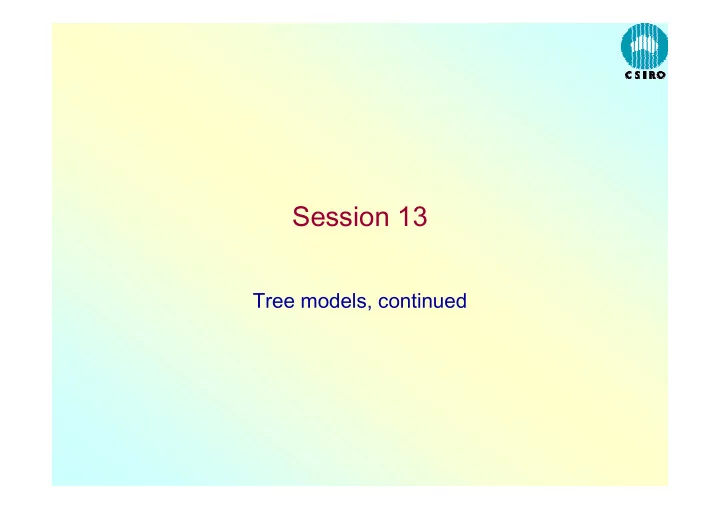

Session 13 Tree models, continued
Classification: more on cars cars93 <- subset(Cars93, select = -c(Manufacturer, Model, Rear.seat.room, Luggage.room, Make)) print(names(cars93), quote = FALSE) [1] Type Min.Price [3] Price Max.Price [5] MPG.city MPG.highway [7] AirBags DriveTrain [9] Cylinders EngineSize [11] Horsepower RPM [13] Rev.per.mile Man.trans.avail [15] Fuel.tank.capacity Passengers [17] Length Wheelbase [19] Width Turn.circle [21] Weight Origin � � ����������������
Project • We want to build a tree classifier for the Type of car from the other variables (no good reason!) • We omit variables that have missing values and factors with large numbers of levels • We use the R tree package for illustrative purposes • The full cycle is – build an initial tree – check size by cross-validation – prune to something sensible � � ����������������
Construction and cross-validation library(tree) cars93.t1 <- tree(Type ~ ., cars93, minsize = 5) x11(width = 8, height = 6) plot(cars93.t1); text(cars93.t1, cex = 0.75) par(mfrow = c(2,2)) for(j in 1:4) plot(cv.tree(cars93.t1, FUN=prune.tree)) # an alternative criterion for(j in 1:4) plot(cv.tree(cars93.t1, FUN=prune.misclass)) � � ����������������
� � ����������������
� � ����������������
for(j in 1:4) plot(cv.tree(cars93.t1, FUN = prune.misclass)) � � ����������������
Pruning • Can use snip.tree () to prune manually • The function prune.tree () enacts optimal deviance pruning • The function prune.misclass () enacts optimal misclassification rate pruning par(mfrow = c(1,2)) cars93.t2 <- prune.misclass(cars93.t1, best = 6) plot(cars93.t2, type = "u"); text(cars93.t2) cars93.t3 <- prune.tree(cars93.t1, best = 6) plot(cars93.t3, type = "u"); text(cars93.t3) • Both methods lead to the same tree, here. � � ����������������
� � ����������������
The confusion matrix is not very confused pred <- predict(cars93.t3, Cars93, type = "class") with(cars93, table(pred, Type)) Type pred Compact Large Midsize Small Sporty Van Compact 15 0 0 1 2 0 Large 0 9 1 0 0 0 Midsize 0 2 19 0 0 0 Small 0 0 0 20 4 0 Sporty 1 0 2 0 8 0 Van 0 0 0 0 0 9 • Real test comes from a train/test sample: exercise! �� � ����������������
Comparison with multinomial library(nnet) # multinomial is a neural network model m <- multinom(Type ~ Width + EngineSize + Passengers + Origin, cars93, maxit = 1000) pfm <- predict(m, type = "class") with(cars93, table(Type, pfm)) pfm Type Compact Large Midsize Small Sporty Van Compact 13 0 1 1 1 0 Large 0 11 0 0 0 0 Midsize 0 1 21 0 0 0 Small 1 0 0 19 1 0 Sporty 1 0 0 2 11 0 Van 0 0 0 0 0 9 �� � ����������������
The special case of one or two predictors • Choose two likely useful predictors: cars.2t <- tree(Type ~ Width + EngineSize, Cars93) par(mfrow = c(1,1)) plot(cars.2t); text(cars.2t) par(mfrow = c(2,2)) for(j in 1:4) plot(cv.tree(cars.2t, FUN=prune.misclass)) par(mfrow = c(1,1)) cars.2t1 <- prune.misclass(cars.2t, best = 6) plot(cars.2t1); text(cars.2t1) partition.tree(cars.2t1) �� � ����������������
�� � ����������������
�� � ����������������
�� � ����������������
An alternative display • If there are only two variables, the tree may be given as a two-dimensional diagram. partition.tree(cars.2t1) with(cars93, { points(Width, EngineSize, pch=8, col = as.numeric(Type), cex = 0.5) legend("topleft", levels(Type), pch = 8, col = 1:length(levels(Type)), bty = "n") }) �� � ����������������
�� � ����������������
janka.t1 <- tree(Hardness ~ Density, janka) partition.tree(janka.t1) with(janka, points(Density, Hardness, col="red")) �� � ����������������
Binary data examples • The credit card data provides a more realistic example. • A previous exercise used this data with rpart • Consider now using the tree package instead. set.seed(32867700) # my home phone number ind <- sample(nrow(CC), 810) CCTrain <- CC[ind, ] CCTest <- CC[-ind, ] Store(CCTrain, CCTest) �� � ����������������
CC.t1 <- tree(credit.card.owner ~ ., CCTrain) par(mfrow = c(2,2)) for(j in 1:2) plot(cv.tree(CC.t1, FUN = prune.misclass)) for(j in 1:2) plot(cv.tree(CC.t1, FUN = prune.tree)) �� � ����������������
Testing CC.t2 <- prune.misclass(CC.t1, best = 6) testPred2 <- function(fit, data = CCTest) { pred <- predict(fit, data, type = "class") Y <- formula(fit)[[2]] Cmatrix <- with(data, table(eval(Y), pred)) tot <- sum(Cmatrix) err <- tot - sum(diag(Cmatrix)) 100*err/tot } testPred2(CC.t1) # [1] 18.39506 testPred2(CC.t2) # [1] 18.27160 �� � ����������������
Simple bagging ### simple bagging baggedTree <- local({ bsample <- function(data) data[sample(nrow(data), rep = TRUE), ] function (object, data = eval(object$call$data), nBags = 200, ...) { bagsFull <- list() for (j in 1:nBags) bagsFull[[j]] <- update(object, data = bsample(data)) attr(bagsFull, "formula") <- formula(object) class(bagsFull) <- "bagTree" bagsFull } }) �� � ����������������
Methods and tests formula.bagTree <- function(x, ...) attr(x, "formula") predict.bagTree <- function(object, newdata, ...) { vals <- sapply(object, predict, newdata, type = "class") svals <- sort(unique(vals)) mVote <- apply(vals, 1, function(x) which.max(table(factor(x, levels = svals)))) svals[mVote] } CC.bag <- baggedTree(CC.t1) testPred2(CC.bag) # [1] 13.70370 �� � ����������������
Random Forests library(randomForest) CC.rf <- randomForest(credit.card.owner ~ ., CCTrain) testPred2(CC.rf) # [1] 13.20988 • Random forests wins, but by a very slight margin • Bagged methods are (in this case) far superior to trees, pruned or otherwise • Also better (again, in this case) than the parametric models. �� � ����������������
Recommend
More recommend